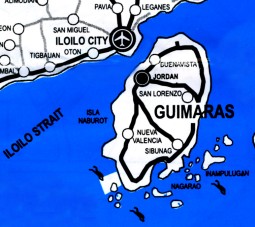

 The Sunday before leaving on my tour I had the opportunity to ride
with the local cycling club on
Guimaras Island,
which is located 20
minutes by ferry across the strait from Iloilo. I met the group
(maybe 12-15 riders) in the parking area of one of the member's
place of business at 7:15 and we rode the half mile or so to the
docks to catch the car ferry to Guimaras.
The Sunday before leaving on my tour I had the opportunity to ride
with the local cycling club on
Guimaras Island,
which is located 20
minutes by ferry across the strait from Iloilo. I met the group
(maybe 12-15 riders) in the parking area of one of the member's
place of business at 7:15 and we rode the half mile or so to the
docks to catch the car ferry to Guimaras.
The mountain bikes were similar to what you would see on a typical ride
in the US. They ranged from entry-level to a fully-suspended
carbon-fiber Cannondale. Most had front shocks and clipless pedals. Not
everyone is poor in the Philippines. There is a sizeable middle class.
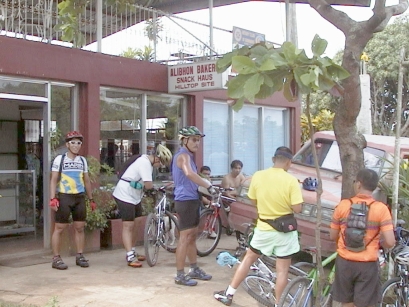 The ride started on pavement with a pretty good 5 mile climb followed
by our first regroup at (where else) a bakery. They regroup often so
everyone can catch up and not miss a turn.
The ride started on pavement with a pretty good 5 mile climb followed
by our first regroup at (where else) a bakery. They regroup often so
everyone can catch up and not miss a turn.
After passing through a little town (San Lorenzo?) we soon ran
out of pavement and most of the rest of the ride was on dirt roads and
trails. The ride had been billed as being mostly on-road, because we had
some heavy rains last week and the ground is still muddy. But they
decided to do a mountain bike ride instead. The ground on Guimaras is
mostly based on crushed limestone/sand, so it is not so bad to ride on
in the wet as the clay soil around Iloilo.
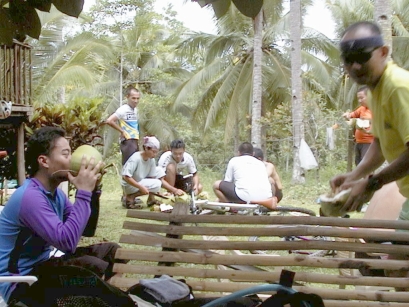 Despite being off-road all day, this roadie only fell once! The bike
slipped out from under me and I fell right in the mud. But by then we
were headed for some property that Edsel, one of the riders, owns on
Guimaras. He let me wash the mud out of my Santa Rosa Cycling Club
jersey at his (hand-cranked) well pump. A guy living on the property
(a renter I guess) shinnied up a coconut tree and threw down a bunch
for us to eat. I drank some of the juice inside and put the rest in my
water bottle. It tasted like slightly-sweet, slightly-flavored water.
One guy said the juice from the coconuts on a friend's farm tastes just
like 7-Up without the fizz.
Despite being off-road all day, this roadie only fell once! The bike
slipped out from under me and I fell right in the mud. But by then we
were headed for some property that Edsel, one of the riders, owns on
Guimaras. He let me wash the mud out of my Santa Rosa Cycling Club
jersey at his (hand-cranked) well pump. A guy living on the property
(a renter I guess) shinnied up a coconut tree and threw down a bunch
for us to eat. I drank some of the juice inside and put the rest in my
water bottle. It tasted like slightly-sweet, slightly-flavored water.
One guy said the juice from the coconuts on a friend's farm tastes just
like 7-Up without the fizz.
We also scooped out the meat from the inside of the coconuts for a
snack. The edible part is less thick than in the ones you buy in the
supermarket back home. He said that they were just the proper stage of
ripeness for eating. If you wait too long, the meat gets thicker but
also hard and rubbery. He said the Ilonggo word for this stage of
ripeness literally means "like snot" which was a pretty accurate
description of the consistency.
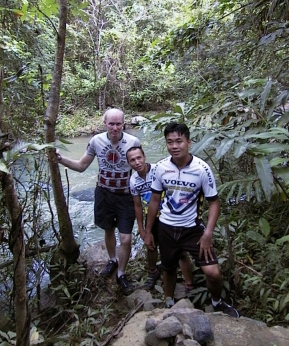 Edsel said the water from the pump is good to drink because it comes
from a spring. With the coconut water, I had enough so I didn't chance
it. Several of us hiked down to the stream on the property and checked
out the spring, which empties into a concrete cistern.
Edsel said the water from the pump is good to drink because it comes
from a spring. With the coconut water, I had enough so I didn't chance
it. Several of us hiked down to the stream on the property and checked
out the spring, which empties into a concrete cistern.
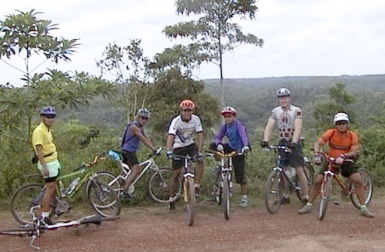
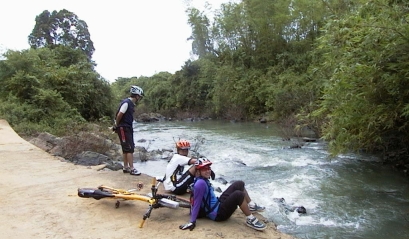 After lazing around there for awhile, we started riding again. I did
OK, but they are much better acclimated to the heat than I am. Plus I
am not a skilled off-road rider. So I was with the front riders on the
paved part but near the back for the off-road part.
After lazing around there for awhile, we started riding again. I did
OK, but they are much better acclimated to the heat than I am. Plus I
am not a skilled off-road rider. So I was with the front riders on the
paved part but near the back for the off-road part.
Guimaras has hundreds of miles of dirt roads and single track. The scenery is lush green jungle with views of the interior mountains and occasional glimpses of the ocean. Even the paved roads have light traffic, so it's a favorite among local cyclists.
Near the end of the ride, we stopped at a
Trappist monestary.
They have a souvenir/snack bar out in front with a fridge filled with ice
cold cokes and bottled water! I had a Coke and then a bottle of water.
Boy did that cold water taste good!
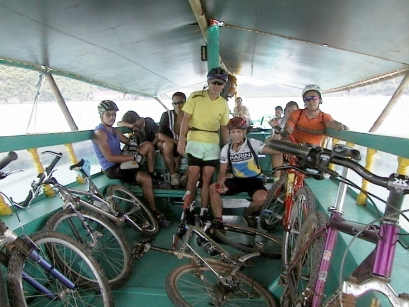 For the return to Panay we didn't want to wait for the car ferry so we
hired a "pump boat" which is a small sharply-prowed wooden boat with
outriggers on bamboo poles. It was interesting getting the bikes on
and off, but I managed it without going for an involuntary swim.
For the return to Panay we didn't want to wait for the car ferry so we
hired a "pump boat" which is a small sharply-prowed wooden boat with
outriggers on bamboo poles. It was interesting getting the bikes on
and off, but I managed it without going for an involuntary swim.
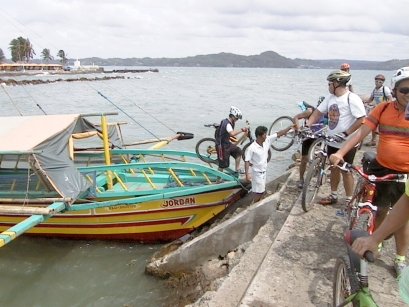 I got a photo of the guys exiting the boat onto the concrete breakwater
that we walked over to get back to shore.
I have been taking lots of photos. After the ride I traded email
addresses with one of the riders and promised to send him copies of the
photos which he will forward to the others. One rider was a student at
CPU from Korea. He and I were the only foreigners.
I got a photo of the guys exiting the boat onto the concrete breakwater
that we walked over to get back to shore.
I have been taking lots of photos. After the ride I traded email
addresses with one of the riders and promised to send him copies of the
photos which he will forward to the others. One rider was a student at
CPU from Korea. He and I were the only foreigners.